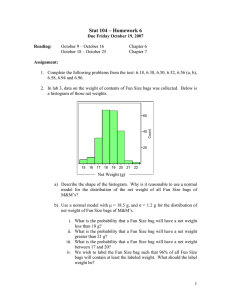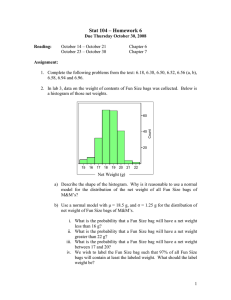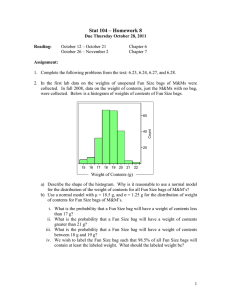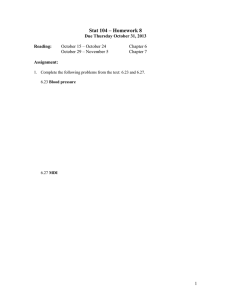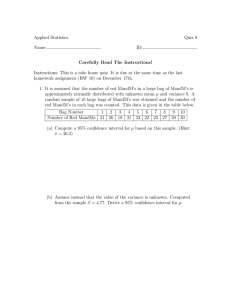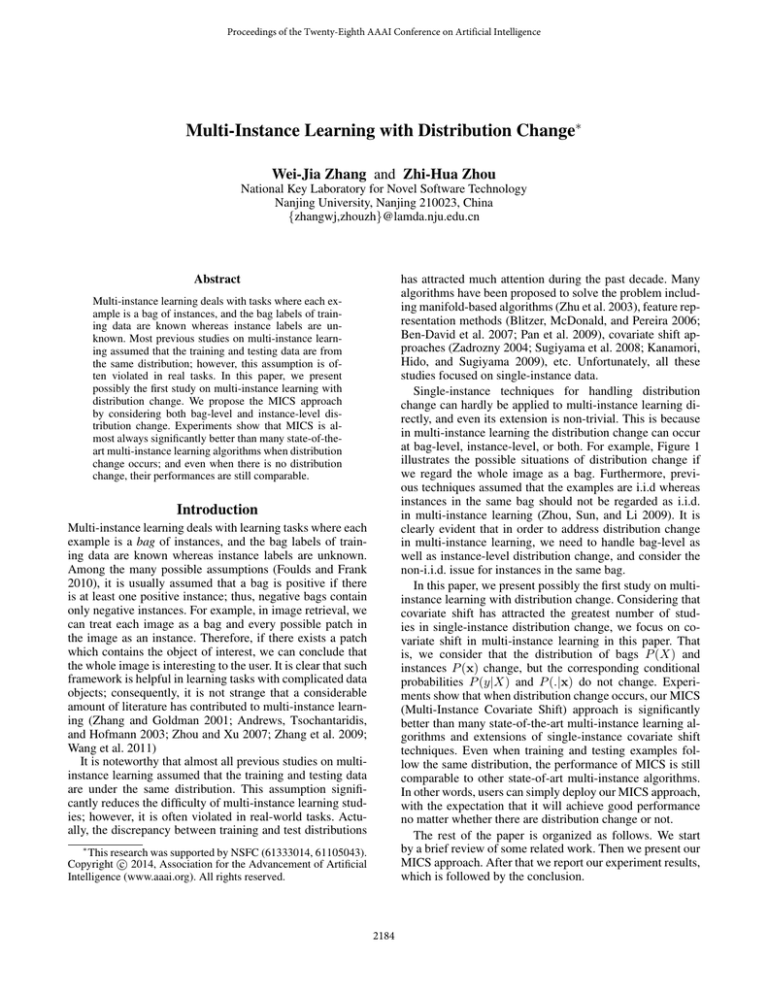
Proceedings of the Twenty-Eighth AAAI Conference on Artificial Intelligence
Multi-Instance Learning with Distribution Change⇤
Wei-Jia Zhang and Zhi-Hua Zhou
National Key Laboratory for Novel Software Technology
Nanjing University, Nanjing 210023, China
{zhangwj,zhouzh}@lamda.nju.edu.cn
Abstract
has attracted much attention during the past decade. Many
algorithms have been proposed to solve the problem including manifold-based algorithms (Zhu et al. 2003), feature representation methods (Blitzer, McDonald, and Pereira 2006;
Ben-David et al. 2007; Pan et al. 2009), covariate shift approaches (Zadrozny 2004; Sugiyama et al. 2008; Kanamori,
Hido, and Sugiyama 2009), etc. Unfortunately, all these
studies focused on single-instance data.
Single-instance techniques for handling distribution
change can hardly be applied to multi-instance learning directly, and even its extension is non-trivial. This is because
in multi-instance learning the distribution change can occur
at bag-level, instance-level, or both. For example, Figure 1
illustrates the possible situations of distribution change if
we regard the whole image as a bag. Furthermore, previous techniques assumed that the examples are i.i.d whereas
instances in the same bag should not be regarded as i.i.d.
in multi-instance learning (Zhou, Sun, and Li 2009). It is
clearly evident that in order to address distribution change
in multi-instance learning, we need to handle bag-level as
well as instance-level distribution change, and consider the
non-i.i.d. issue for instances in the same bag.
In this paper, we present possibly the first study on multiinstance learning with distribution change. Considering that
covariate shift has attracted the greatest number of studies in single-instance distribution change, we focus on covariate shift in multi-instance learning in this paper. That
is, we consider that the distribution of bags P (X) and
instances P (x) change, but the corresponding conditional
probabilities P (y|X) and P (.|x) do not change. Experiments show that when distribution change occurs, our MICS
(Multi-Instance Covariate Shift) approach is significantly
better than many state-of-the-art multi-instance learning algorithms and extensions of single-instance covariate shift
techniques. Even when training and testing examples follow the same distribution, the performance of MICS is still
comparable to other state-of-art multi-instance algorithms.
In other words, users can simply deploy our MICS approach,
with the expectation that it will achieve good performance
no matter whether there are distribution change or not.
The rest of the paper is organized as follows. We start
by a brief review of some related work. Then we present our
MICS approach. After that we report our experiment results,
which is followed by the conclusion.
Multi-instance learning deals with tasks where each example is a bag of instances, and the bag labels of training data are known whereas instance labels are unknown. Most previous studies on multi-instance learning assumed that the training and testing data are from
the same distribution; however, this assumption is often violated in real tasks. In this paper, we present
possibly the first study on multi-instance learning with
distribution change. We propose the MICS approach
by considering both bag-level and instance-level distribution change. Experiments show that MICS is almost always significantly better than many state-of-theart multi-instance learning algorithms when distribution
change occurs; and even when there is no distribution
change, their performances are still comparable.
Introduction
Multi-instance learning deals with learning tasks where each
example is a bag of instances, and the bag labels of training data are known whereas instance labels are unknown.
Among the many possible assumptions (Foulds and Frank
2010), it is usually assumed that a bag is positive if there
is at least one positive instance; thus, negative bags contain
only negative instances. For example, in image retrieval, we
can treat each image as a bag and every possible patch in
the image as an instance. Therefore, if there exists a patch
which contains the object of interest, we can conclude that
the whole image is interesting to the user. It is clear that such
framework is helpful in learning tasks with complicated data
objects; consequently, it is not strange that a considerable
amount of literature has contributed to multi-instance learning (Zhang and Goldman 2001; Andrews, Tsochantaridis,
and Hofmann 2003; Zhou and Xu 2007; Zhang et al. 2009;
Wang et al. 2011)
It is noteworthy that almost all previous studies on multiinstance learning assumed that the training and testing data
are under the same distribution. This assumption significantly reduces the difficulty of multi-instance learning studies; however, it is often violated in real-world tasks. Actually, the discrepancy between training and test distributions
⇤
This research was supported by NSFC (61333014, 61105043).
Copyright c 2014, Association for the Advancement of Artificial
Intelligence (www.aaai.org). All rights reserved.
2184
(a) Positive training example:
a red fox in grass.
(b) Bag-level distribution change:
wolves in negative bags.
(c) Instance-level change:
a gray fox in grass.
(d) Instance-level change:
a red fox in snow.
Figure 1: Illustration of the possible distribution changes in multi-instance learning. The learning target is ”fox”. 1) A training
image showing a red fox in grass. 2) Bag-level distribution change: testing images are foxes and other animals. 3) Instance-level
distribution change: testing images are gray foxes, not red ones. 4) Instance-level distribution change: testing images are foxes
in snow, not in green grass.
Related Work
The MICS Approach
Notations
Multi-instance learning originated from the investigation of
drug activity prediction (Dietterich, Lathrop, and LozanoPérez 1997). Since then, many algorithms have been developed. To name a few, Diverse Density and EM-DD
(Maron and Ratan 1998; Zhang and Goldman 2001), boosting and resampling methods MIBoosting (Xu and Frank
2004), SMILe (Doran and Ray 2013), large-margin and kernel methods MI-Kernel (Gärtner et al. 2002), mi-SVM and
MI-SVM (Andrews, Tsochantaridis, and Hofmann 2003),
MissSVM (Zhou and Xu 2007), PPMM (Wang, Yang, and
Zha 2008), M3 IC (Zhang et al. 2009), eMIL (Krummenacher, Ong, and Buhmann 2013), Multi-instance learning
techniques have been applied to diverse applications such as
image classification and retrieval (Maron and Ratan 1998),
text categorization (Andrews, Tsochantaridis, and Hofmann
2003), computer-aided medical diagnosis (Fung et al. 2007),
etc. It is noteworthy that all previous studies of multiinstance learning assumed that the training and testing examples are drawn from the same distribution.
Distribution change between training and testing examples is a common phenomenon in real-world machine learning applications. In covariate shift, it is assumed that the distributions of data examples P (x) differ between training and
testing data, but the conditional distribution of the class label
given the examples P (y|x) stays the same. In this situation,
minimizing empirical risk on training data will cause the
learned model to be fitted better to regions with high training density, but we actually want the model to be fitted better to regions with high testing density. Covariate shift techniques aim to solve this problem by incorporating the importance weights w(x) = ptest (x)/ptrain (x) into the training phase of single-instance learning algorithms. weighting
the training examples according to the importance weight
w(x) = ptest (x)/ptrain (x). Many algorithms have been
proposed to estimate the above weight, such as Kernel Density Estimation, Kernal Mean Matching (Huang et al. 2007),
KLIEP (Sugiyama et al. 2008), LSIF and uLSIF (Kanamori,
Hido, and Sugiyama 2009), etc. Unfortunately, all previous
studies on covariate shift focus on single-instance learning.
Before presenting the details, we introduce our notations.
Let X denote the instance space and Y denote the label space. The learner is given a set of m training examtr
, ym )},
ples Dtrain = {(X1tr , y1 ), . . . , (Xitr , yi ), . . . , (Xm
where Xi = {xi1 , . . . , xiu , . . . , xini } ✓ X is called
a bag with ni instances and yi 2 Y = { 1, +1} is
the label of Xi . Here xiu 2 X is an instance xiu =
[xiu1 , . . . , xiul , . . . , xiud ]0 , in which xiul is the value of
xiu at the l-th attribute, and d is the number of attributes.
In standard multi-instance assumption, if there exists t 2
{1, . . . , ni } such that xit is a positive instance, then Xi is
a positive bag and thus yi = +1; if all instances in Xi are
negative, yi = 1. Yet the value of index t is unknown.
In covariate shift, the learner is also given a set of n unlabeled testing bags Dtest = {X1te , . . . , Xnte }. The goal is to
generate a good learner to predict the labels for the bags in
Dtest based on the labeled training data and unlabeled testing data. When discussing distribution change, we use subscripts train and test to denote the distribution of training
and testing examples, respectively.
The Goal
In single-instance learning, algorithms treat each instance
as an example. Accordingly, covariate shift techniques in
single-instance learning aim to estimate the importance
weight for each instance; then incorporate the estimated
weights into single-instance learning algorithms. Thus, a
straightforward way to deal with multi-instance covariate
shift is to consider the instances in multi-instance bags as
i.i.d samples, estimate the importance weights w(x) =
ptest (x)/ptrain (x) for the instances in training bags with
respect to the instances in testing bags by directly applying
importance weighting techniques in single-instance learning, and then incorporate the estimated weights to existing
multi-instance learning algorithms. However, such a strategy
not only neglects the fact that instances in a multi-instance
bag are usually not i.i.d, but also ignores the possibility
that distribution change can happen both at bag-level and
2185
There are many existing techniques to estimate the parameters ↵p . In this paper, we estimate them by minimizing the
least square loss between Ŵ (X) and W (X) as follows:
at instance-level in multi-instance learning. Before presenting our MICS approach, we start by taking a closer look
at the different possibilities of distribution change in multiinstance learning.
In multi-instance learning, the first situation of distribution change is possible to happen at bag-level. The
bag distributions of training and testing sets are different,
Ptrain (X) 6= Ptest (X), whereas the conditional distributions of label given the bag stay unchanged, Ptrain (y|X) =
Ptest (y|X). For example, in a image classification task
where positive examples in training set are images with red
fox (Figure 1.a) and negative examples are mostly taken in
urban area(i.e., car, human, beaches, buildings, etc.), while
the examples in testing set are positive images of foxes and
many images of wolves (Figure 1.b). In this case, the classifier built solely on the training set would try to discriminate
animals images and non-animal images. However, in order
to achieve good performance on testing set, we actually want
the classifier to emphasize on discriminating foxes and other
animal images such as wolves.
The second situation of multi-instance distribution change
is possible to happen at instance-level. Formally, the distributions of instances in the bags change, Ptrain (x) 6=
Ptest (x); whereas the conditional probability do not change,
Ptrain (.|x) = Ptest (.|x), implying that whether an instance
is relevant or irrelevant to the user’s interest stays unchanged
between training and testing sets. For example, instancelevel distribution change happens when the data were collected near a habitat of red fox, and thus the positive images in training set are mostly red foxes (Figure 1.a); while
the testing examples were collected near a gray fox habitat, where the positive images are mostly gray foxes (Figure
1.c). It is also possible that the training images were mostly
taken in summer, where the positive images were mostly
foxes in grass (Figure 1.a); but the testing images were taken
in winter, where the positive images were mostly presented
with snowy background (Figure 1.d). Note that the distribution change of single-instance learning lies in the examplelevel as each example is represented by a single feature vector, whereas the instance-level distribution change of multiinstance learning occurs at the level of building blocks of an
example, as each example is a set of instances.
It is noteworthy that the bag-level and instance-level distribution change may take place simultaneously, making the
situation of distribution change in multi-instance learning
much more complicated than single-instance learning.
Z
1
(Ŵ (X) W (X))2 ptr (X)dX
2
Z
1
=
(Ŵ (X)2 ptr (X) 2Ŵ (X)W (X)ptr (X)
2
+ W (X)2 ptr (X))dx,
(2)
L0 (↵) =
Given a training set, the third term in Eq.2 is a constant and
therefore can be safely ignored during optimization. Let us
denote the first two terms of Eq.2 by L, since W (X) =
pte (X)/ptr (X), we have:
Z
Z
1
Ŵ (X)2 ptr (X)dX
Ŵ (X)pte (X)dX
L(↵) =
2
Z
b
1 X
=
↵p ↵p0 ( 'p (X)'p0 (X)ptr (X)dX)
2 0
p,p =1
b
X
=
↵p 'p (X),
ĥ> ↵,
(3)
1
(4)
min [ ↵> Ĥ↵ ĥ> ↵ + ↵> ↵].
b
2
↵2R 2
It is evident that the solution of (4) can be analytically
computed as ↵ = (Ĥ + Ib ) 1 ĥ, where Ib is the bdimensional identity matrix, therefore the parameters can
be efficiently estimated. It is noteworthy that in singleinstance learning the basis functions 'p (x) can be chosen as
a fixed number of Gaussian kernels centered at test points
(Sugiyama et al. 2008; Kanamori, Hido, and Sugiyama
2009), but here we need to use a kernel to capture the similarity information between multi-instance bags. In this paper
we use the MI-Kernel (Gärtner et al. 2002) as follows:
We now propose our MICS approach. To handle the baglevel distribution change, we treat each multi-instance bag as
an entity and estimate the importance weight of bag W (X)
by the following linear model
Ŵ (X) =
1 >
↵ Ĥ↵
2
'p (X)pte (X)dX)
where Ĥ be the
with the (p, p0 )th-element
Pmb ⇥ b matrix
tr
tr
0
'
(X
)'
as hp,p0 =
p (Xi )/m and h be the
i
i=1 p
b-dimensional vector with the p-th element as ĥp =
P
n
te
j=1 'p (Xj )/n. From Eq.3, we can estimate the coefficients {↵p }bp=1 by solving the following optimization problem:
The Solution
b
X
↵p (
p=1
Z
kM I (Xi , Xj ) =
nj
ni X
X
kg (xiu , xjv )
(5)
u=1 v=1
where kg (xiu , xjv ) = exp( ||xiu xjv ||2 ) is a RBF kernel and is the kernel width.
We now discuss how to handle instance-level distribution change. If we treat instances in the same bag as i.i.d.
samples, the instance-level distribution change can be simply handled by estimating wi.i.d. (xiu ) = pte (xiu )/ptr (xiu )
with single-instance covariate shift techniques. However,
(1)
p=1
where ↵p are parameters to be learned from data and 'p (X)
are the basis functions such that 'p (X) 0 for all X 2 D
and p = 1, . . . , b.
2186
such a simple solution, implying that we can get even better performance by considering better weight incorporation
strategies; this is a future issue to be explored.
previous studies (Zhou, Sun, and Li 2009) disclosed that an
important property of multi-instance learning lies in the fact
that the instances in the same bag are usually related, and
they should not be treated as i.i.d. samples. If we simply
treat instances in the same bag as i.i.d. samples, then there
is no need to consider multi-instance learning(Zhou and Xu
2007). Thus, when addressing the instance-level distribution
change, we need to consider the non-i.i.d. issue.
As (Zhou, Sun, and Li 2009) shows, ✏-graph is a simple yet effective way for considering the relations between
instances in the same bag. Inspired by their work, we
use ✏-graph to help estimate the instance-level importance
weights. For each bag Xi , we construct an ✏-graph Gi =
(Vi , Ei ), where every instance in Xi is a node of Gi . We
then compute the distance of every pair of nodes by the Euclidean distance d(xiu , xiv ) = ||xiu xiv ||2 . If the distance between xiu and xiv is smaller than ✏, we establish
an edge between them. Since the graph is constructed by
thresholding the edges with ✏, we treat each edge in graph
Gi as equally weighted. Let Di denote the degree matrix of
Gi and diu denote the uth diagonal element of Di . We estimate the instance-level importance weight w(xiu ) for the
u-th instance in bag Xi by
w(xiu ) = wi.i.d. (xiu )/(diu + 1).
Experiments
In this section, we empirically evaluate the performance
of the proposed MICS approach. We compare MICS with
a set of state-of-the-art multi-instance learning algorithms.
Firstly, considering that our MICS is a kind of SVM-style
approach, we compare with mi-SVM (Andrews, Tsochantaridis, and Hofmann 2003), which is a famous multiinstance SVM algorithm. Secondly, considering that we
have motivated the study by using some image data, whereas
MILES (Chen, Bi, and Wang 2006) is known as an effective
multi-instance algorithm for image tasks, we include it as a
baseline for comparison. Thirdly, since we incorporate our
importance weights into Eq.5 proposed by (Gärtner et al.),
we also include MI-Kernel as a baseline. Moreover, we have
been inspired by miGraph (Zhou, Sun, and Li 2009) to treat
instances in the same bag as non-i.i.d. samples, and therefore, we also include miGraph in comparison.
To study whether the direct application of single-instance
distribution change techniques can work with multi-instance
learning, we compare with some baselines. Note that there
was no algorithm for multi-instance distribution change before, and thus, we derive two algorithms. The first one,
mi-SVM+, is a variant of mi-SVM working by using the
single-instance covariant shift algorithm (Kanamori, Hido,
and Sugiyama 2009) to estimate the weights for each instances, and incorporating these weights directly to miSVM. The second algorithm, MILES+, is a variant derived
from MILES in a similar way.
Considering that in the study of distribution change, we
need to get access to the test data (otherwise we could not estimate the difference between training/testing distribution),
we believe that we should compare with semi-supervised
multi-instance learning algorithms that exploit information
in the unlabeled testing data. For this purpose, we compare with MissSVM (Zhou and Xu 2007), a semi-supervised
multi-instance learning algorithm. During the experiments,
the parameters are selected via 5-folds cross validation on
the training data.
(6)
To understand the intuition of w, consider that with the
constructed ✏-graph, nodes in the same clique can be regarded as related to each other. For a bag Xi , the u-th diagonal element diu represents the number of instances related to
the u-th instance. Thus, if all nodes in Gi are not connected
to each other, then none of the instances belongs to the same
clique and each instance is treated equally; if the nodes in Gi
are clustered into cliques, the contribution of the instances to
its concept is related to the number of nodes in each clique;
if all the nodes of Gi are connected to each other, thus all
instances in the bag belong to the same concept and each
instance contributes identically.
After we estimate the bag-level weights W (X) and
instance-level weights w(x), there are many ways to incorporate them into existing multi-instance algorithms. For example, for multi-instance algorithms directly deal with instances, we can incorporate the weights as wiu = W (Xi ) ·
w(xiu ); for multi-instance algorithms that transform bags
into entities and classify the transformed ones, the instancelevel weights can be incorporated in the bag transformation
step and bag-level weights in the classification step. In this
paper, we simply modify the multi-instance kernel in Eq.5
to incorporate the weights as follows:
kM ICS (Xi , Xj ) =
nj
ni X
X
u=1 v=1
Experiments on Text Data Sets
First, we perform experiments on text data sets based on
the 20 Newsgroups corpus popularly used in text categorization. Each of the 20 news categories corresponds
to a data set. Similar to (Settles, Craven, and Ray 2007;
Zhou, Sun, and Li 2009), here each positive bag contains
approximately 3% posts drawn from the target category,
whereas the other instances in positive bags and the instances in negative bags are drawn from non-target categories. Each instance is a post in the corpus represented
by the top 200 TFIDF features. We then use a deliberately biased sampling procedure to separate the examples
into disjoint training and testing sets. The biased selection scheme is similar as the one used in (Zadrozny 2004;
Huang et al. 2007). In detail, we define a random variable si
!iu · !jv · kg (xiu , xjv ), (7)
where !iu = W (Xi ) · w(xiu ), !jv = W (Xj ) · w(xjv ). As
can be seen, we use a very straightforward method to incorporate the instance-level and bag-level important weights,
and it is very likely that there are many advanced techniques
that can do better than such a simple strategy of weight incorporation. However, in the next section we can see that
the proposed MICS method has already worked well with
2187
Table 1: Testing accuracy (%, mean ± std.) on text categorization tasks. The best performance and its comparable results (paired
t-tests at 95% significance level) are bolded. The last row shows the win/tie/loss counts of MICS versus other methods.
Dataset
alt.atheism
comp.graphics
comp.os.ms-win
comp.sys.ibm.pc
comp.sys.mac
talk.politics.guns
talk.politics.mideast
talk.politics.misc
comp.windows.x
rec.autos
rec.sport.hockey
sci.crypt
misc.forsale
sci.med
sci.electronics
rec.sport.baseball
rec.motocycles
soc.religion.christ
sci.space
talk.religion.misc
MICS: W/T/L
mi-SVM
83.0±2.1
84.6±1.9
76.1±2.2
62.6±3.1
75.7±1.2
76.8±1.3
76.2±2.5
78.4±1.3
70.4±2.6
76.7±2.4
66.3±1.2
66.4±1.8
73.4±2.0
70.2±1.3
64.6±2.5
58.5±1.4
65.0±1.9
50.0±0.0
58.7±3.3
50.2±0.1
20/0/0
MILES
70.0±3.3
59.2±3.0
62.8±3.3
62.4±3.9
64.8±3.8
68.0±3.4
64.8±3.3
72.4±3.5
64.8±3.7
59.2±3.7
59.2±3.0
69.6±3.6
64.8±4.1
64.0±3.2
55.6±2.8
60.8±3.5
71.2±3.2
67.6±3.4
64.4±3.3
62.0±3.2
20/0/0
MI-Kernel
54.8±3.0
51.2±1.8
52.4±3.0
52.0±2.0
52.4±3.0
58.0±3.0
50.4±1.9
51.6±2.4
55.2±3.4
53.6±3.4
52.8±3.4
63.6±3.6
55.6±3.0
51.6±2.2
53.6±2.4
54.0±32.
68.8±4.1
52.0±1.4
59.6±3.5
52.0±2.2
20/0/0
miGraph
65.5±4.0
77.8±1.6
70.1±1.5
59.5±2.7
79.4±4.8
72.3±2.1
75.5±2.7
73.8±3.7
71.0±2.8
71.8±3.1
70.1±2.5
72.1±2.1
65.2±1.7
72.1±3.9
84.0±3.4
64.7±4.7
75.0±6.0
59.0±2.6
75.7±3.6
67.5±3.5
20/0/0
MissSVM
78.0±1.4
83.2±1.8
76.5±2.3
68.6±2.5
72.3±1.8
78.6±1.2
78.8±1.3
74.6±2.4
72.0±1.9
70.5±2.0
70.5±1.8
75.5±2.4
67.4±1.6
75.9±2.0
68.8±2.5
63.4±2.4
69.2±1.9
58.0±2.1
70.2±3.2
60.5±1.8
20/0/0
mi-SVM+
84.3±1.5
83.6±1.3
84.6±1.6
62.3±2.1
82.6±1.4
78.7±1.6
89.3±1.0
80.3±1.5
71.0±2.5
76.3±1.9
60.1±1.8
78.8±1.6
82.5±1.2
88.2±1.2
65.0±2.8
57.3±1.5
64.0±2.0
50.0±0.0
58.7±1.6
50.2±0.5
15/1/4
MILES+
69.4±3.3
61.0±3.3
62.1±3.6
64.5±3.8
61.7±3.7
68.5±3.5
68.0±3.3
70.6±3.5
66.7±3.7
56.6±3.6
59.3±3.0
69.3±3.6
57.1±4.0
63.8±3.1
54.9±2.7
60.6±3.5
71.9±3.3
67.0±3.4
63.3±3.3
60.1±3.2
20/0/0
MICS
86.8±3.2
86.0±3.4
78.8±3.0
80.4±3.3
84.4±3.4
80.4±2.4
83.2±3.2
78.4±3.4
84.4±3.6
86.0±2.8
90.8±2.2
88.4±2.9
82.0±2.4
88.4±1.6
94.0±3.0
86.0±3.4
86.0±2.5
82.0±2.3
81.2±2.4
77.2±3.3
-
Experiments on Image Data Sets
for all the bags in the data set, where si = 1 indicates the ith
bag is selected into training set, and si = 0 otherwise. Since
smaller feature values predominate
P in the unbiased data, we
sample according to P (si = 1| u,l xiul 3) = 0.2 and
P
P (si = 0| u,l xiul > 3) = 0.8. In other words, the testing bags have higher density of instances with small feature
values instances than the training bags, whereas the training
bags have higher density of instances with large feature values. Note that in this series of experiments we only consider
the bag-level distribution change.
Then, we perform experiments on a number of COREL image datasets. Each image is regarded as a bag, whereas the
single-blob approach (Maron and Ratan 1998) is used to extract regions in the image as instances. Here each bag contains 16 instances described by color features.
In this series of experiments we consider both the baglevel and instance-level distribution changes. We split the
images in each class into training and testing sets with
similar sizes. We first change the bag-level distribution by
putting negative bags from different classes into training and
testing sets. Then we change the instance-level distribution
by bias sampling the positive instances. For example, in the
fox data set, the training positive examples mostly includes
pictures that contain red fox with snow background, while
testing positive examples contain mostly gray foxes with forest and grass background. The negative bags in training set
are mostly consist of natural scene images (beach, building,
forest) whereas those in testing set are mostly consist of animal images (lion, dog, tiger).
On each dataset we repeat the experiments for 25 times
and report the average accuracy with standard deviations
in Table 2, with the best results and its comparable ones
(paired t-tests at 95% significance level) bolded. It is observable that existing multi-instance learning algorithms fail to
achieve good performance when distribution change occurs.
It is noteworthy that the mi-SVM+ algorithm does not work
either, possibly because that now the tasks suffer from both
bag-level and instance-level distribution changes. MILES+
improves performance of MILES on some datasets, but it
worsen the performance on sunset and text. Table 2 shows
On each data set we repeat the experiments for 25 times
using the above described biased sampling strategy to generate random training/testing splits, where half of the data are
used for training and the other half are used for testing. The
average accuracy with standard deviation are reported in Table 1, with the best results and its comparable ones (paired
t-tests at 95% significance level) bolded. We can see that
existing multi-instance algorithms fail to achieve good performance when distribution change occurs. By incorporating single-instance covariate shift techniques, mi-SVM+ and
MILES+ becomes better than mi-SVM and MILES on only
a small number of datasets. It is worth noting that the incorporation of single-instance distribution change techniques
does not necessarily lead to better performances; for example, the performance of mi-SVM+ is worse than mi-SVM
on comp.graphics and rec.sport.hockey; the performance of
MILES+ is worse than MILES on comp.sys.mac.hardware
and misc.forsale. Except 4 losses to mi-SVM+, MICS outperforms other algorithms on all datasets.
2188
Table 2: Testing accuracy (%, mean ± std.) on image classification tasks. The best performance and its comparable results
(paired t-tests at 95% significance level) are bolded. The last row shows the win/tie/loss counts of MICS versus other methods.
Dataset
fox
wolves
mountain
sunset
car
MICS: W/T/L
mi-SVM
73.2±0.4
74.5±0.2
94.3±0.2
64.6±0.1
83.4±0.3
5/0/0
MILES
74.4±2.9
80.1±2.1
87.5±2.2
80.4±2.5
81.8±2.9
5/0/0
MI-Kernel
74.0±3.3
68.8±3.2
76.0±3.9
76.4±3.8
84.8±3.4
5/0/0
miGraph
71.2±2.8
75.4±2.4
92.4±1.5
78.5±3.1
88.4±1.5
5/0/0
MissSVM
75.8±0.4
76.8±0.3
86.4±0.1
67.5±0.2
78.5±0.3
5/0/0
mi-SVM+
73.3±0.2
74.5±0.1
94.4±0.1
64.6±0.1
83.4±0.2
5/0/0
MILES+
73.2±3.4
86.5±1.9
96.5±1.4
68.1±1.8
85.3±2.0
4/1/0
MICS
79.0±0.6
86.2±1.2
98±0.3
83.8±0.4
94.0± 0.5
-
Parameter Influence
that on image datasets, our MICS approach achieves the best
performance and it is evidently able to handle both bag-level
and instance-level distribution changes.
At last, we perform sign-tests and Friedman-tests in conjunction with Bonferroni-Dunn at 95% significance level to
determine whether there is any significant difference between the compared algorithms. Both tests show the same
results: in terms of all twenty-five datasets mentioned above,
MICS is significantly better than all of the compared algorithms.
To study the influence of the ✏ value (used for the ✏-graph)
on the performance of MICS, we perform additional experiments with varied ✏ values. Figure 2 shows some results
where each point corresponds to the average performance of
the experiments repeated for ten times. We can see that the
tuning of ✏ values enables MICS to have good performance,
which indicates the effectiveness of considering instances in
the bags as non-i.i.d. samples.
Experiments on Data Sets without Distribution
Change
Table 3: Test accuracy (%) on benchmark data sets without distribution change. Performance of the compared algorithms are obtained from related literature (N/A means the
result is not reported in the corresponding literature).
Dataset
mi-SVM
MILES
MI-Kernel
miGraph
MissSVM
MICS
Musk1
87.4
84.2
82.0
88.9
87.6
88.0
Musk2
83.6
83.8
86.8
90.3
80.0
90.0
Elept
82.0
89.1
N/A
86.8
N/A
86.0
Fox
58.2
76.0
N/A
61.6
N/A
72.7
ε
ε
(a) Sunset
Tiger
78.9
86.0
N/A
85.6
N/A
86.0
(b) Mountain
Figure 2: Parameter Sensitivity Comparisons
Conclusion
Previous studies on multi-instance learning assumed that the
distribution of test set is exactly the same as the distribution
of training set, although in real-world tasks their distributions are often different. Directly applying single-instance
distribution change techniques to multi-instance learning
will not lead to good performance, because in multi-instance
learning the distribution change may occur both at the baglevel and instance-level. In this paper, we propose the MICS
approach and experiments show that our MICS approach
not only performs significantly better than many state-of-art
multi-instance learning algorithms when distribution change
occurs, but also achieves competitive result when distributions of training and testing examples are the same.
There is much future work to do. To name a few, it will be
interesting to study other assumptions of distribution change
in multi-instance learning. Employing advanced techniques
to handle the non-i.i.d. issue of instances in the same bag
may lead to better performance. Moreover, developing refined strategies for incorporating the bag-level and instancelevel importance weights might be even more helpful.
Currently, there is no reliable techniques available for detecting whether distribution change occurs. Therefore, we
evaluate MICS on benchmark datasets where there is no distribution change. Similar to the experimental settings used
in previous multi-instance learning studies, we conduct 10fold cross validations for ten times, and report the average
performances in Table 3. Sign-tests and Friedmann-tests in
conjunction with Bonferroni-Dunn at 95% significance level
show that there are no significant differences between these
algorithms over five benchmark datasets. It indicates that,
although our MICS approach is designed for multi-instance
learning with distribution change, its performance is comparable with state-of-art multi-instance algorithms on datasets
without distribution change. As we have mentioned, currently there is no effective routine to detect whether distribution change occurs or not, thus MICS is particularly a good
option because it works well no matter whether there is distribution change or not.
2189
References
Sugiyama, M.; Nakajima, S.; Kashima, H.; Buenau, P. V.;
and Kawanabe, M. 2008. Direct importance estimation with
model selection and its application to covariate shift adaptation. In Advances in Neural Information Processing Systems
20. 1433–1440.
Wang, H.; Huang, H.; Kamangar, F.; Nie, F.; and Ding, C. H.
2011. Maximum margin multi-instance learning. In Advances in Neural Information Processing Systems 24. 1–9.
Wang, H.-Y.; Yang, Q.; and Zha, H. 2008. Adaptive pposterior mixture-model kernels for multiple instance learning. In Proceedings of the 25th International Conference on
Machine Learning, 1136–1143.
Xu, X., and Frank, E. 2004. Logistic regression and boosting
for labeled bags of instances. In Advances in Knowledge
Discovery and Data Mining. Springer. 272–281.
Zadrozny, B. 2004. Learning and evaluating classifiers under sample selection bias. In Proceedings of the 21st International Conference on Machine Learning, 114–121.
Zhang, Q., and Goldman, S. A. 2001. EM-DD: An improved
multiple-instance learning technique. In Advances in Neural
Information Processing Systems 14. 1073–1080.
Zhang, D.; Wang, F.; Si, L.; and Li, T. 2009. M3IC: Maximum margin multiple instance clustering. In Proceedings of
the 21st International Joint Conference on Artificial Intelligence, 1339–1344.
Zhou, Z.-H., and Xu, J.-M. 2007. On the relation between
multi-instance learning and semi-supervised learning. In
Proceedings of the 24th International Conference on Machine learning, 1167–1174.
Zhou, Z.-H.; Sun, Y.-Y.; and Li, Y.-F. 2009. Multi-instance
learning by treating instances as non-i.i.d. samples. In Proceedings of the 26th International Conference on Machine
Learning, 1249–1256.
Zhu, X.; Ghahramani, Z.; Lafferty, J.; et al. 2003. Semisupervised learning using gaussian fields and harmonic
functions. In Proceedings of the 20th International Conference on Machine Learning, 912–919.
Andrews, S.; Tsochantaridis, I.; and Hofmann, T. 2003. Support vector machines for multiple-instance learning. In Advances in Neural Information Processing Systems 15. 561–
568.
Ben-David, S.; Blitzer, J.; Crammer, K.; and Pereira, F.
2007. Analysis of representations for domain adaptation.
In Advances in Neural Information Processing Systems 19.
137–144.
Blitzer, J.; McDonald, R.; and Pereira, F. 2006. Domain
adaptation with structural correspondence learning. In Proceedings of the 2006 Conference on Empirical Methods in
Natural Language Processing, 120–128.
Chen, Y.; Bi, J.; and Wang, J. Z. 2006. MILES: Multipleinstance learning via embedded instance selection. IEEE
Transactions on Pattern Analysis and Machine Intelligence
28(12):1931–1947.
Dietterich, T. G.; Lathrop, R. H.; and Lozano-Pérez, T.
1997. Solving the multiple-instance problem with axisparallel rectangles. Artificial Intelligence 89(1-2):31–71.
Doran, G., and Ray, S. 2013. SMILe: Shuffled multipleinstance learning. In Proceedings of the 27th AAAI Conference on Artificial Intelligence, 260–266.
Foulds, J., and Frank, E. 2010. A review of multi-instance
learning assumptions. The Knowledge Engineering Review
25(1):1–25.
Fung, G.; Dundar, M.; Krishnapuram, B.; and Rao, R. B.
2007. Multiple instance learning for computer aided diagnosis. In Advances in Neural Information Processing Systems
19. 425–432.
Gärtner, T.; Flach, P. A.; Kowalczyk, A.; and Smola, A. J.
2002. Multi-Instance Kernels. In Proceedings of the 19th
International Conference on Machine Learning, 179–186.
Huang, J.; Smola, A. J.; Gretton, A.; Borgwardt, K. M.; and
Schlkopf, B. 2007. Correcting sample selection bias by unlabeled data. In Advances in Neural Information Processing
Systems 19. 601–608.
Kanamori, T.; Hido, S.; and Sugiyama, M. 2009. A leastsquares approach to direct importance estimation. Journal
of Machine Learning Research 10:1391–1445.
Krummenacher, G.; Ong, C. S.; and Buhmann, J. 2013. Ellipsoidal multiple instance learning. In Proceedings of the
30th International Conference on Machine Learning, 73–81.
Maron, O., and Ratan, A. L. 1998. Multiple-instance learning for natural scene classification. In Proceedings of the
15th International Conference on Machine Learning, 341–
349.
Pan, S. J.; Tsang, I. W.; Kwok, J. T.; and Yang, Q. 2009.
Domain adaptation via transfer component analysis. In Proceedings of the 21st International Joint Conference on Artificial Intelligence, 1187–1192.
Settles, B.; Craven, M.; and Ray, S. 2007. Multiple-instance
active learning. In Advances in neural information processing systems 19. 1289–1296.
2190


